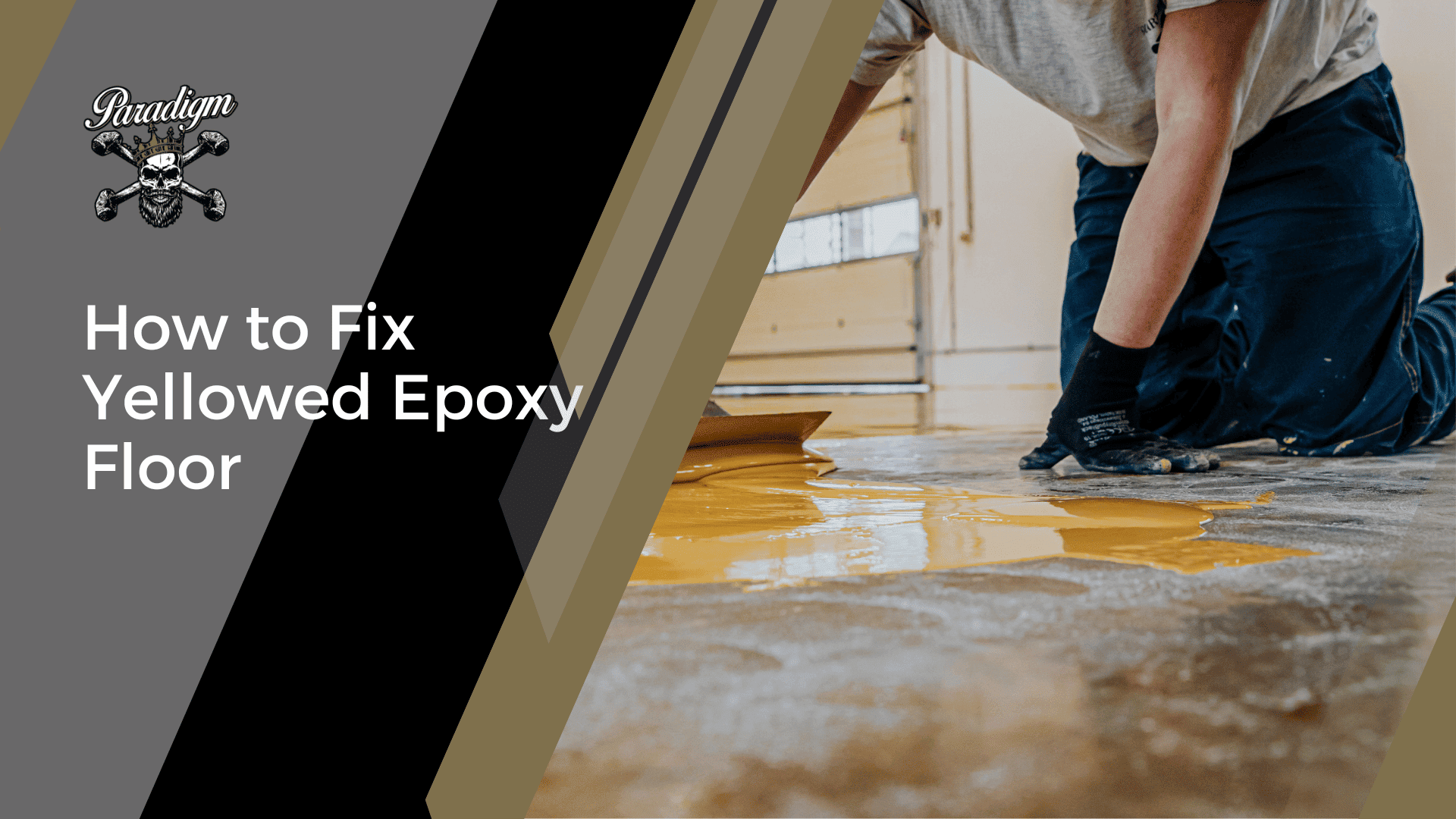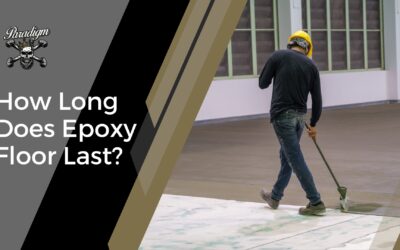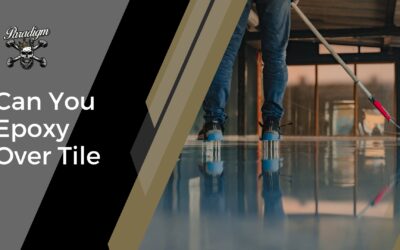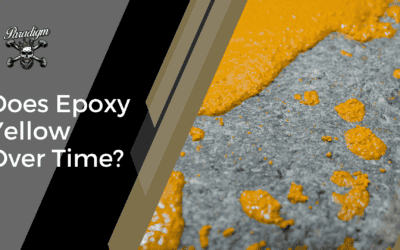Epoxy floors, known for their exceptional durability and ability to withstand heavy traffic and chemical spills, have gained immense popularity in garage flooring. Homeowners opt for epoxy floors as a long-lasting and low-maintenance solution.
However, over time, epoxy floors may develop a yellowish tint that can diminish their visual appeal. If you find yourself facing this issue, don’t worry because you are about to find effective solutions on how to fix yellowed epoxy floor in no time.
The yellowing of epoxy floors can occur due to various factors, including UV exposure, chemical reactions, or improper installation techniques. It’s important to identify the underlying cause before proceeding with the restoration process.
Table of Contents
What causes yellowing on epoxy floor?
The following are some factors that can cause your epoxy floor to turn yellow:
- Prolonged exposure to sunlight and ultraviolet rays can cause the epoxy resin to break down and oxidize, resulting in a yellowish tint.
- Certain chemicals, such as ammonia-based cleaners or acidic substances, can react with the epoxy resin and cause discoloration.
- Incorrectly mixing the epoxy resin components can lead to uneven curing and yellowing of the floor.
- Insufficient cleaning or improper moisture control during the surface preparation phase can affect the adhesion and appearance of the epoxy floor, potentially leading to yellowing.
- Using subpar or low-quality epoxy products can contribute to yellowing and discoloration over time.
Also, as epoxy floors age and endure regular wear and tear, they become more prone to yellowing due to the accumulation of dirt, grime, and exposure to various elements. This is why you must take preventive measures and implement proper maintenance practices to keep your epoxy floor looking its best.
How to Fix Yellowed Epoxy Floor
If you are wondering about how to fix yellowed epoxy floor, here’s a step-by-step guide for you:
Step 1: Evaluate the yellowing
Begin by assessing the extent of the yellowing on your epoxy garage floor. This will help you identify the areas that are affected by the discoloration.
Step 2: Clean the surface
Thoroughly clean the entire floor surface using a mild detergent or a specialized epoxy floor cleaner. This way, you can remove any dirt, dust, or contaminants that could interfere with the repair process.
Step 3: Sand the floor
Use a fine-grit sandpaper or a floor sander to gently sand the yellowed areas of the epoxy floor. The goal is to remove the discolored top layer and expose the fresh, unaffected epoxy beneath. Be careful not to apply excessive pressure or sand too deeply to avoid damaging the floor.
Step 4: Clean the sanded area
After sanding, clean the sanded areas to remove any sanding residue or dust. Use a vacuum cleaner or a soft cloth to ensure the surface is clean and ready for the next step.
Step 5: Apply a new epoxy layer
Prepare a fresh batch of epoxy resin according to the manufacturer’s instructions. Apply it evenly and smoothly over the sanded areas using a roller or a brush. Ensure that the new epoxy layer seamlessly blends with the existing floor. You should also attention to any edges or transitions to maintain a uniform appearance.
Step 6: Allow curing
Let the newly applied epoxy layer cure and dry completely. Follow the recommended curing time provided by the epoxy manufacturer and avoid walking or placing any objects on the floor during this curing period to achieve the best results.
Is epoxy bad if it turns yellow?
No, epoxy is not necessarily bad if it turns yellow. The yellowing of epoxy is primarily a cosmetic issue and does not indicate damage or affect the durability or performance of the epoxy floor.
As mentioned earlier, yellowing on epoxy floors is a common occurrence due to factors like UV exposure or chemical reactions.
How can you keep your garage floor clean?
Incorporating some maintenance practices into your routine would help you keep your epoxy garage floor looking clean, attractive, and in the best condition for years to come. To keep your garage floor clean and well-maintained, follow these simple tips:
1. Regular sweeping or vacuuming
Regular sweeping or vacuuming helps prevent the buildup of dirt and grime. That is why you should use a broom or a vacuum cleaner with a soft brush attachment to remove loose debris from the surface of your epoxy garage floor.
2. Promptly wipe up spills
Accidental spills, such as oil, grease, or chemicals, should be promptly cleaned up to avoid stains and potential damage to the epoxy surface. Use an absorbent cloth or paper towels to blot and wipe the spills away.
3. Mild cleaning solutions
For routine cleaning, use a mild detergent or an epoxy floor cleaner mixed with water. Follow the manufacturer’s instructions for dilution ratios. Apply the solution to the floor, scrub gently with a soft-bristle brush or mop, and rinse thoroughly with clean water.
4. Avoid abrasive cleaners or tools
Harsh chemicals, abrasive cleaners, or rough scrub brushes can damage the epoxy surface. Stick to mild cleaning solutions and soft-bristle brushes to avoid scratching or dulling the floor.
5. Protect the floor from heavy objects
Place mats or protective pads under heavy objects like car jacks, toolboxes, or workbenches to prevent them from scratching or denting the epoxy floor surface.
6. Regular maintenance
Periodically inspect your garage floor for any signs of damage or wear. Address any issues promptly to prevent further damage and maintain the longevity of your epoxy floor. This may include reapplying a topcoat or addressing any cracks or chips.
How to prevent epoxy resin yellowing
You can prevent epoxy resin yellowing by choosing a UV-resistant epoxy. Here are other things you can do to significantly maintain the long-lasting beauty of your epoxy floor:
1. Choose UV-resistant epoxy
Opt for UV-resistant epoxy coatings specifically designed to withstand prolonged exposure to sunlight and ultraviolet rays. These coatings have additives that help protect the epoxy from yellowing over time.
2. Proper surface preparation
Ensure thorough surface preparation before applying epoxy. Clean the surface meticulously to remove any dirt, grease, or contaminants that can interfere with the adhesion of the epoxy. Follow the manufacturer’s guidelines for recommended cleaning methods and drying times.
3. Use high-quality epoxy products
Select high-quality epoxy products from reputable manufacturers. These products are often formulated with superior ingredients that provide better resistance to yellowing and discoloration.
4. Adequate ventilation
Proper ventilation during the installation and curing process is crucial. Ensure the area is well-ventilated to allow for the release of any volatile compounds that could contribute to yellowing. This can help promote the proper curing of the epoxy and minimize the risk of discoloration.
5. Avoid harsh chemicals and cleaners
Refrain from using harsh chemicals or cleaners that may react with the epoxy and cause yellowing. Opt for mild, epoxy-safe cleaning solutions when maintaining the floor to avoid any potential chemical reactions.
6. Regular maintenance
Implement a regular maintenance routine that includes gentle cleaning with mild detergents or epoxy-specific cleaners. Promptly clean up spills and avoid allowing substances to sit on the epoxy surface for extended periods, as this can lead to discoloration.
Are There Epoxy Floor Coatings That Won’t Yellow?
Yes, there are epoxy floor coatings available that are specifically formulated to resist yellowing. These coatings are designed with additives and technologies that provide enhanced UV resistance, hence reducing the yellowing effect. Benefits of these specialized coatings include:
- They maintain the original appearance of the floor, resisting yellowing and discoloration caused by UV exposure.
- These coatings offer exceptional resistance to abrasion, chemicals, and other forms of wear, ensuring a longer lifespan for your epoxy floor.
- The coatings’ ability to resist yellowing helps keep the floor looking visually appealing and professional.
Note that these specialized coatings may come with some drawbacks and potentially higher costs compared to standard epoxy coatings. The added technologies and UV-resistant properties can increase the overall price of the product. Also, the availability of specific brands and products may vary depending on your location.
Before choosing a specific epoxy floor coating, consider your budget, and the level of yellowing resistance required, and speak with professionals or product experts to determine the best option for your needs.




